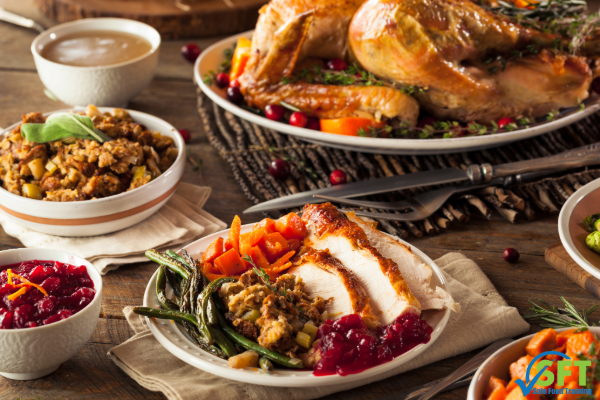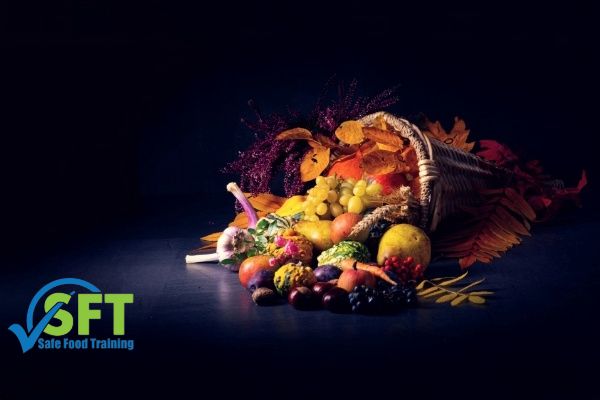
Certified food protection managers across Minnesota are deep in planning for the modern Thanksgiving feast. In our last post, we covered the critical safety checks for this meal, from thawing the turkey to cooling the leftovers. This high-pressure, high-risk meal is a true test of any food service operation.
But it begs the question: is this complex meal we serve today the same one the Pilgrims and Wampanoag shared in 1621? The classic painting of a perfect, golden-brown turkey on a platter is a staple of American history. Or is it?
Let’s look at what history tells us, and what it means for today’s food safety professionals.
The Myth: What We Think They Ate
When we plan a “traditional” Thanksgiving menu, we’re thinking of a very specific set of items:
- Roast Turkey with Gravy
- Bread-based Stuffing
- Mashed Potatoes
- Cranberry Sauce
- Candied Yams or Sweet Potatoes
- Pumpkin Pie
For a CFPM, this menu lists Time/Temperature Control for Safety (TCS) foods. You must cook the turkey to 165°F, the stuffing (if cooked separately) to 165°F, and hot-hold everything above 135°F or cool it using the two-stage method.
This menu poses a major safety challenge. But it’s nothing compared to what was actually served.
The Reality: The Real 1621 Menu
According to the two surviving accounts of the 1621 harvest feast, the menu was far more rustic and varied. It was a true hunter-gatherer’s meal, heavily influenced by what the Wampanoag guests brought.
- Wild Fowl and Venison: Turkey was present, but it wasn’t the star. Accounts mention a “great store of wild turkeys” as well as geese and ducks. The Wampanoag also contributed five deer, making venison a centerpiece of the meal.
- Seafood: Being a coastal New England settlement, the feast was heavy on seafood. This likely included mussels, clams, oysters, lobster, and eel—all staples of the local diet.
- Native produce: Potatoes and yams were unknown to the Pilgrims. Instead, they would have eaten native New England produce like pumpkin and other squashes (roasted in the fire, not baked in a pie) and corn, which was likely served as a “mush” or cornbread.
- Missing in Action: Cranberry sauce? Not for another 50 years. Butter and wheat flour for pie crusts? The Pilgrims had no ovens and limited supplies.
A CFPM’s Nightmare: The 1621 Food Safety Challenge
Today’s Thanksgiving is a challenge of process. The 1621 feast would have been a challenge because of limited ingredients and the risk of cross-contamination.
Imagine you’re the certified food protection manager for this 1621 feast. Your top concerns wouldn’t just be one turkey; they would be:
- Massive Cross-Contamination Risk: You aren’t just prepping one type of raw protein. You are butchering and cooking wild-caught venison, multiple types of waterfowl, and prepping raw seafood. The risk of spreading pathogens from the field-dressed deer to the mussels or roasted squash would be astronomical without separate, color-coded prep areas.
- High-Risk Seafood: Mussels, clams, and oysters are some of the high-risk foods we handle. They are filter feeders that can harbor Vibrio bacteria or norovirus. Without modern refrigeration, these would have to be harvested and cooked immediately—any delay would be a public health disaster.
- No “Danger Zone” Control: The entire concept of hot-holding at 135°F or cold-holding at 41°F was nonexistent. Someone cooked and served the food over an open fire. This single-service event is actually safer in one way: there were no leftovers. The modern challenge of rapidly cooling leftover gravy and stuffing (a process that, when done wrong, is a leading cause of Clostridium perfringens) wasn’t a problem.
What Today's Thanksgiving Teaches Us



The first Thanksgiving was a rugged, single-service event based on immediate consumption. The modern Thanksgiving, in contrast, is a complex test of a food safety system.
The Pilgrims’ menu was varied, but our modern meal truly tests a Certified Food Protection Manager’s training. We manage a high-volume, multi-step process of thawing, cooking, hot-holding, serving, and (most importantly) cooling.
This modern complex process is where your training becomes critical. As you complete your Thanksgiving prep, make sure your certification is up to date. Safe Food Training offers the expert-led 8-hour Certified Food Protection Manager course and 3-year continuing education for you and your team in Minnesota.
Visit our website to book your training and head into the holidays with confidence.


